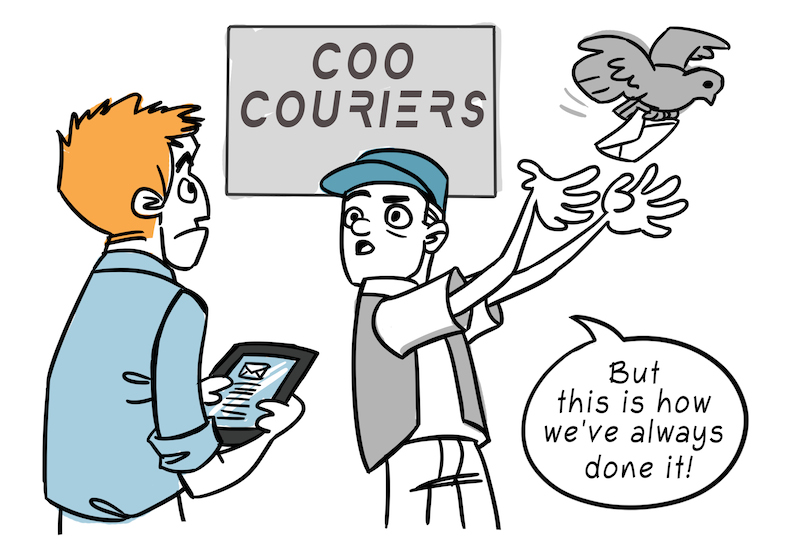Going “Agile” can be daunting for teams used to working with other software development methodologies, let alone adjusting to changes in their physical working environment. People are often resistant to change for a wide range of reasons and this resistance can make the switch both complicated and emotionally exhausting for individual team members.
However, there are ways you can make the Agile journey less painful for newcomers. Here I provide examples of methods I’ve discovered from personal experience and discuss how you can create greater team chemistry along the way.
Agile requires a different physical environment
Let’s think of the typical office layout in a suit and tie organisation. There’s probably large cubicles with tall partitioning, dedicated offices for managers, boring white walls, lots of files/paper laying around – the list goes on. Some of these elements can be barriers to communication and collaboration, both of which are critical to the success of going Agile.
Many companies are now adopting ‘smart environments’ that include new office layouts and ways of working (Google was one of the first to try this and succeed). These smart environments have proven to be a great way to work. They encourage interaction between colleagues and create a stimulating workplace that people love to be in every day.
What are the characteristics of a smart environment?
- Open spaces – encouraging people to talk without having to battle partitions is a great way to spark exciting work conversations between those that might not usually interact. It inspires sharing, collaborative learning and new ideas
- Innovation spaces – these give workers all the tools and technologies they need to smash out a piece of work, workshop ideas or even hold an iteration/sprint with the entire team in close proximity
- Hot desk policies – enabling people to sit anywhere they like fosters close collaboration when required
- Whiteboard walls – allowing team members to write on any wall in the office without needing to find a whiteboard keeps great ideas top of mind with the entire staff
- Themed spaces – breaking up the stereotypical boring office format by brightening up walls and furniture encourages different ideas. It can also make everyone feel more comfortable about sharing their thoughts about a project.
Agile requires a certain mindset
Agile is not a process. It’s a way of thinking. There’s no clear path or end state; instead we find ourselves in a frequently changing and evolving environment.
It’s important that everyone is along for the journey and open to new ideas, especially if your team has no previous knowledge of Agile methodologies. Those with closed minds or who are stuck in THWADI (i.e. “that’s the way we’ve always done it”) are guaranteed to upset momentum, putting more strain on your project and your team’s focus.
When working with Agile, it’s key for team members to be motivated, keen to learn and willing to adopt new ways of thinking. Why?
- They’ll absorb more information, and at a faster rate, if they’re engaged
- The more passionate they are, the better job they will do
- Their enthusiasm rubs off on other team members
- They make a coach’s life easier!

Agile needs to permeate the organisational culture
Employee behaviour is important when you’re setting up a new team and introducing new ways of working. Company culture – including things like vision, values, beliefs and habits – can influence and impact on behaviour.
To create a high performing Agile team, your company culture should support the four core values outlined in the Agile Manifesto:
- Individuals and their interactions
- Delivering working software
- Customer collaboration
- Responding to change.
A mismatch between these values and an organisation’s culture can interrupt different aspects of learning in a development team, but all stakeholders (customer, management, delivery team) need to share the same “Agile mindset” to successfully adopt a new way of delivery.
For instance, management may have an alternative view to those who are actually doing the work. It may view Agile not as a change of mindset but a way of accelerating delivery. However, one of the first things a company or team should do before trying Agile is focus on the Agile/Lean core values (above) and set aside methods previously used for software delivery.
Thought processes should be centred on:
- Delivering value to the customer
- Eliminating waste
- Continuous improvement
- Communication
- Feedback
- Incremental delivery.
For example – If your project has 200 user stories, it might not be viable to deliver all of these stories. Instead, you should work on the top 10% of features that provide the most value. Then you can work with the customer on incremental releases by focusing on previous learning (feedback), while continuously improving your deliverables.
Going agile requires tracking progress
A vital process in anything you do is to always measure, reflect and improve. It’s a must do when creating a new Agile team.
Why? To make sure you’re going in the right direction. The last thing you want is to introduce a new way of working and not gather feedback on how it’s performing. Feedback metrics help you decide whether Agile is the right approach for your needs.
You can use a survey format to gather feedback – as an example I’ve chosen the Agile flavour ‘scrum.’ This includes questions such as:
- How would you rate your overall feelings of scrum?
- How much business value was delivered using scrum?
- How was collaboration and co-operation in the team that used scrum?
- What amount of time was wasted/ work thrown out using scrum?
- Was their greater clarity of goals/ did the team deliver?
Once these metrics are gathered, you can draw a chart to tell a story about the feedback, then discuss the results with your team.

In a retrospective style, you can use the above visual aid to discuss findings with your team and further dive into the reasoning behind ratings. This provides a forum to examine opinions, gather action items and further improve.
Coach, don’t dictate
Just like any high performing sports team, it’s important to appoint a coaching team in the early stages of adopting Agile. An Agile coach is your team’s motor. He or she is there to continuously improve Agile understanding.
I once heard about an Agile coach who discovered a team was missing daily stand-ups on certain days. The coach’s response was to distribute a set of core Agile principles and DEMAND the team followed them. The subsequent reaction was unexpected. The team felt it was being treated unfairly and refused to ask the coaching staff for assistance again.
This example illustrates that (surprise, surprise!) people often don’t like being blatantly told to do something, even when ceasing engagement with their coaching team negatively affects their learning process.
As an Agile coach, you should take your team on the journey with you. Team members need to see the benefits a particular methodology can deliver. By building a sense of trust and rapport with others, they become more willing to listen and learn.
It’s often a double-edged sword, though. Do you modify scrum to fit the organisation – even to the extent that it no longer works? Or do you enforce a by-the-book adoption that might make people hesitant to work with you?
Unfortunately, there’s no silver bullet for successfully implementing Agile in new teams. However, there are a lot of helpful techniques you can use to make the process less painful and really accelerate the maturity of your team. I hope this blog has given you some food for thought on how you can proceed.
Further reading:


